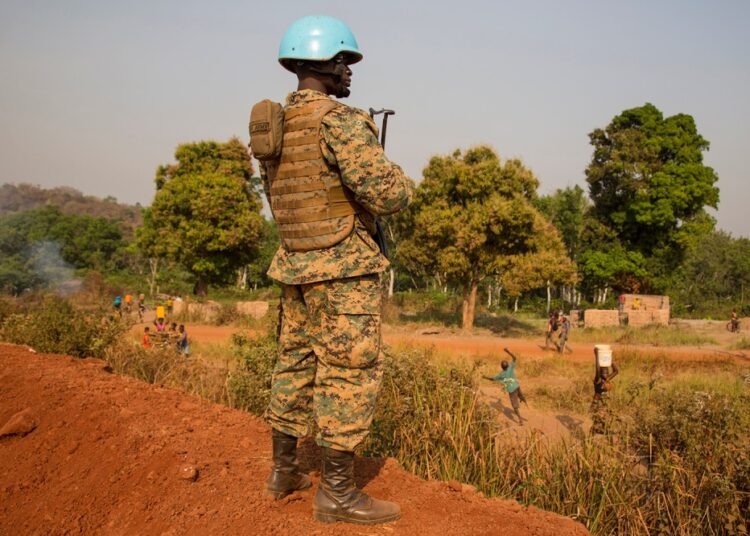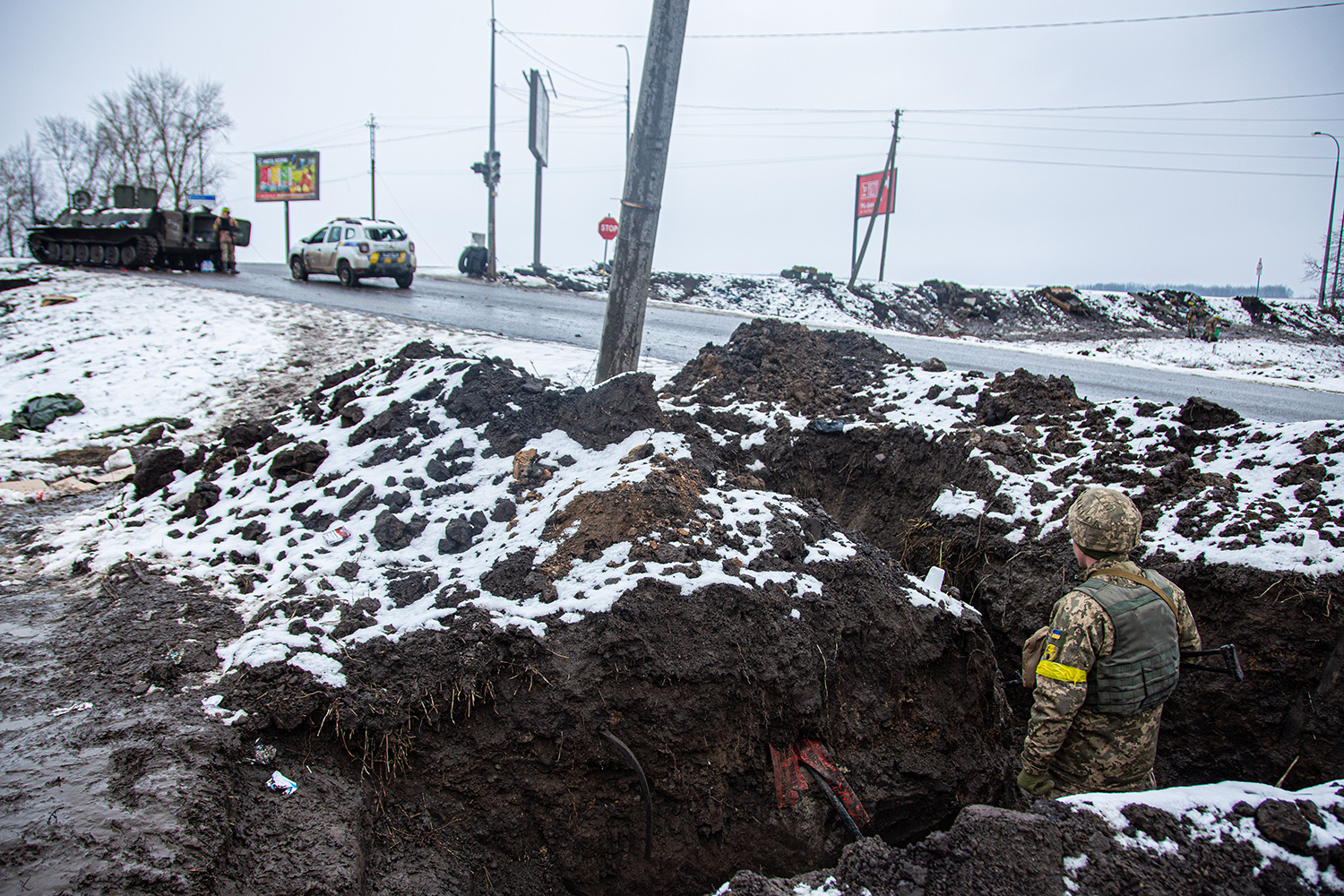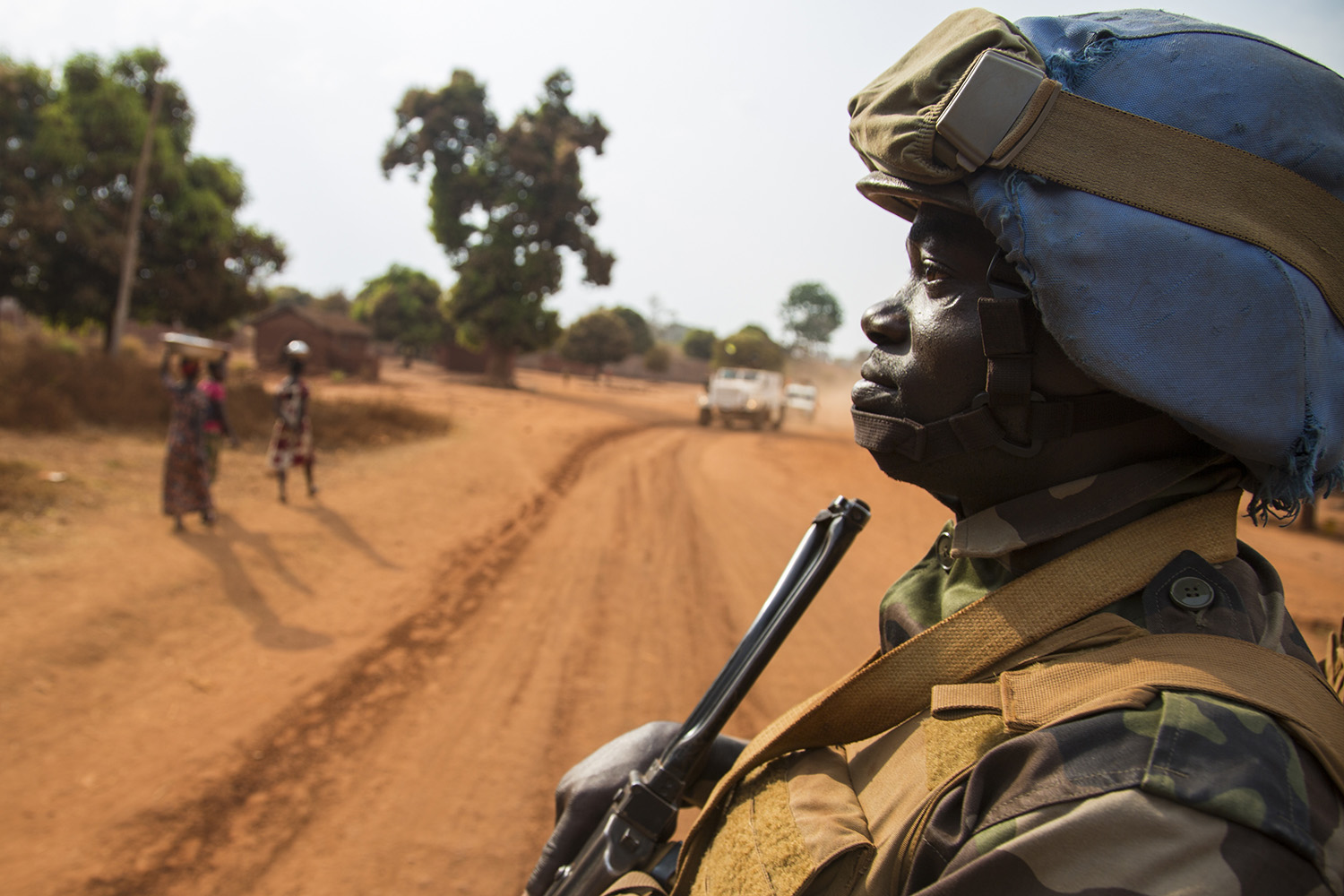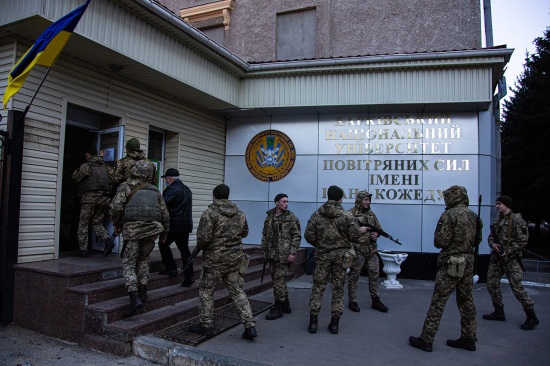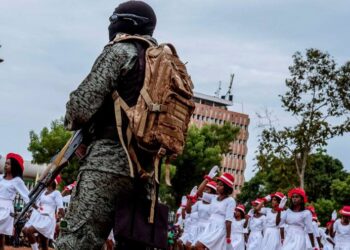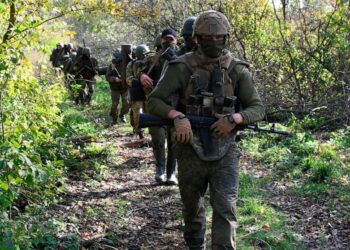In June 2021, four young Syrian men were on the final leg of their journey to the Central African Republic. As their connecting flight took off from Lomé, Togo’s capital, the contrast between the boisterous, bedraggled group and their fellow passengers—African businessmen, U.N. officials, affluent local families, charity workers—could not have been more striking.
Covered in dirt, talking loudly in Arabic, and taking photos nonstop from their economy-class seats, they wore open-toed sandals and had the look of farm workers who had rarely, if ever, traveled by plane. On arrival in Bangui, CAR’s capital, a white soldier dressed in the typical attire of personnel working for the Wagner Group, a Russian network of mercenaries and paramilitaries, collected them from the tarmac and took them into the terminal.
Inside, he showed airport guards a special letter branded with the Russian coat of arms before whisking them out through a back door.
A U.N. peacekeeper keeps guard in Bria in the Central African Republic on Feb. 8, 2018, a town then held by rebels before Russia-backed government forces moved in. Jack Losh photos for Foreign Policy
In June 2021, four young Syrian men were on the final leg of their journey to the Central African Republic. As their connecting flight took off from Lomé, Togo’s capital, the contrast between the boisterous, bedraggled group and their fellow passengers—African businessmen, U.N. officials, affluent local families, charity workers—could not have been more striking.
Covered in dirt, talking loudly in Arabic, and taking photos nonstop from their economy-class seats, they wore open-toed sandals and had the look of farm workers who had rarely, if ever, traveled by plane. On arrival in Bangui, CAR’s capital, a white soldier dressed in the typical attire of personnel working for the Wagner Group, a Russian network of mercenaries and paramilitaries, collected them from the tarmac and took them into the terminal.
Inside, he showed airport guards a special letter branded with the Russian coat of arms before whisking them out through a back door.
“The Russians know it is going to be a long fight in CAR and you need these young men to fight and die,” said a Central African source several weeks later; the person had direct knowledge of the incident and spoke on condition of anonymity given security concerns. “No one cares what happens to them.”
The fate of those four particular men is not known. But their deployment to that distant conflict last year, alongside many more Syrian mercenaries, may now illuminate what Ukraine can expect after Russian President Vladimir Putin gave the green light for thousands of fighters from the Middle East to join Russia’s newest theater of war.
Some reports say an advance force of around 150 Syrian soldiers had arrived in Russia by last week; a Syrian NGO puts the number closer to 800. The U.S. Defense Department said there are no indications of Syrians fighters in Ukraine as yet, though Wagner is active there, mainly in the Donbas region.
Moscow entered CAR’s conflict in late 2017 as part of an effort to gain influence across the continent, bolstering the country’s beleaguered government forces with weapons, ammunition, and so-called military instructors. These were later confirmed to be mercenaries from Wagner, who have fought in hot spots around the world, including in Libya, Syria, and Ukraine, where its hired guns were first sent to fight in the Donbas in 2014. Wagner’s paramilitaries have been accused of committing numerous human rights violations, including abductions, rape, torture, and execution.
Billboards in central Bangui, the capital of the Central African Republic, promote the rival Russian and French presence in the country on June 11, 2019.
In late 2020, as a loose coalition of rebels launched a nationwide offensive in CAR, government forces fought back with the help of those Russian paramilitaries. Keen to boost its manpower and minimize Russian casualties, Wagner began bringing in fighters from its footholds in the Middle East—namely, Syrian areas controlled by the Russian-backed Assad regime and Libyan districts held by military commander Khalifa Haftar, a key Moscow ally. Both have reportedly offered to support Russia’s offensive in Ukraine.
Little is known about this Libyan and Syrian dimension of the CAR war, itself an underreported conflict. But the few details that have emerged offer a window into how Syrians might be deployed in Ukraine.
There are already some sharp differences. In CAR, Wagner recruiters placed a greater emphasis on quantity over quality. There, as pro-government forces struck back against rebels last year, fresh recruits were needed as guards to hold towns, roads, and mines freed from the insurgent armed groups, allowing state units—and the more experienced mercenaries who had trained them—to continue the fight elsewhere.
Now, following the Russian invasion, analysts are seeing an entirely different operation— a formalized, state-backed process that is going after loyal and experienced Syrian fighters. Rather than using Russian security companies to subcontract the hired guns, Russian military commanders are overseeing the recruitment drive, assisted by Syrian military commanders, rather than militias and local travel agents.
Russia is reportedly using the Syrian regime’s military apparatus to vet and process new recruits systematically, overhauling previous haphazard recruitment drives that pulled Syrian fighters into Moscow’s campaigns in Libya and CAR. Rather than gambling on unemployed men desperate for work and former militia fighters with questionable loyalty, the selection is now focused on elite, battle-hardened Syrian soldiers, particularly those who fought in Russian-led military operations in their country.
- A Ukrainian soldier looks out from a trench on the outskirts of Kharkiv, in northeastern Ukraine, on Feb. 26.
- A U.N. peacekeeper patrols Bria on Feb. 8, 2018.
“[The process] differs significantly from past mercenary recruitment processes carried out by the Russians,” a Syrian NGO wrote in a confidential memo, seen by Foreign Policy, to brief Western diplomats on the current extent and strategy of this recruitment drive. “[It] focuses only on those ideologically loyal to Russia and the Syrian regime, thereby excluding all resettled former opposition fighters or other individuals requiring rigorous vetting in a bid to avoid infiltration by those suspected of links to hostile countries.”
Regime units targeted for recruitment include divisions that helped Syrian President Bashar al-Assad recapture lost territory in the ongoing, 11-year civil war, including those that fought in Aleppo and others that were put together and equipped by the Russians.
“This is very different from what we’ve seen before, where they basically just collected up the riffraff, militias, mercenaries, and any sort of gun for hire,” said a senior member within the NGO, who briefed Foreign Policy on the above memo. The source requested anonymity given the sensitivity of the work, which involved gathering information from political and military sources close to the recruitment drive. “That is a step change from what we’ve seen previously.”
Once that pool of elite Syrian troops is drained—or if the Assad regime places a limit on the number of its soldiers being seconded—other forces experienced in urban combat could be deployed. These include the tens of thousands of fighters from the National Defense Forces (NDF), which emerged from pro-Assad militias early in the Syrian war and could now be drawn on for Russia’s stalled, multifront offensive in Ukraine.
Last week, NDF commanders said they were ready to fight in Ukraine in support of Russia but had not yet been told to go. “Once we get instructions from the Syrian and Russian leadership, we will fight this righteous war,” said Nabil Abdallah, an NDF commander in the Syrian town of Suqaylabiyah. “We will wage street wars and [apply] tactics we acquired during our battles that defeated the terrorists in Syria.”
The current mission to bring Syrian soldiers into Ukraine is of a different magnitude than Russia’s previous mercenary operations. Unlike the four Syrian men who flew into Bangui last June on a West African commercial airline (although others used military transport as well), European officials and Syrian researchers say new recruits bound for Ukraine are being flown into Russia exclusively on military aircraft, having been escorted by Russian forces to their air base in Hmeimim, in northwestern Syria. Investigators with the U.N. panel of experts on the CAR conflict reported that some Syrian fighters were deployed in the country on a three-month contract; that might be an indication of the time frame for Russia’s Syrian mercenaries in Ukraine. But it’s also a journey into the unknown.
“Once these guys get on a plane, they’re essentially Russian property,” said Gregory Waters, a nonresident scholar at the Middle East Institute.
And as more photos of destroyed Russian tanks and dead Russian soldiers reach the social media feeds of Syrian soldiers, that could dent the recruitment drive.
Ukrainian soldiers arrive at their barracks in Kharkiv on Feb. 24.
“People have been finding creative ways, without coming across as disloyal, to stay in Syria,” Waters added. “They’re pushing the rumor that the rebels are going to do an offensive in Idlib, and therefore they have to stay to defend against that.”
Yet the economic lure could still swell the ranks, especially as the deployment has the added benefit of putting these Syrian men “on Europe’s doorstep,” the Syrian NGO memo added. Monthly salaries reportedly range from $500 to $3,000 depending on experience—lucrative sums compared with the average Syrian soldier’s paycheck—in addition to compensation for injury or death.
Following their arrival in Russia, Syrian troops are likely to be deployed directly to front lines in Ukraine, given their prior training, proficiency with Russian equipment, and combat experience under Russian leadership. What is less certain, however, is the conditions they will face in the field, although footage of Russian military vehicles without gas and Russian soldiers looting shops for provisions does not bode well for them.
Neither did previous gigs in CAR. There, poorly paid and badly equipped Syrian and Libyan fighters carried out widespread looting—stealing chickens, goats, and other livestock as well as money, motorbikes, and even mattresses—during house-to-house searches. Flown into an equatorial conflict zone blighted by malaria, dengue, and yellow fever, some even lacked mosquito nets.
One factor driving Damascus to allow the enlistment of its soldiers is the debt it owes Russia for boosting the regime’s war effort in Syria, though the main impact of their Ukrainian deployment may be felt more at home. While foreign fighters refill the ranks of Russia’s battered invasion force, experts say Syrian casualties could strain relations with the Kremlin’s closest ally in the Middle East.
“Deploying substantial numbers … would weaken Russian proxies in Syria while also fueling anti-Russian sentiment as people realize the deployed men were sent to the slaughter,” Waters wrote recently.
“Such sentiment is already on the rise as Syrians are increasingly angry over Russia’s inaction against Israeli airstrikes and perceived unwillingness to fully conquer the opposition-held Idlib territory. As one NDF officer described the changing situation, ‘People are starting to realize bit by bit that Syria and Russia are not one and that Russia just follows Russian interests.’”
People ride motorcycles through the streets of Bangui on Jan. 19, 2018.
Russia’s growing use of mercenaries—a practice as old as war itself—has helped advance the Kremlin’s foreign-policy goals at low cost while also fueling human rights abuses under a cloak of deniability. And as Russia prepares its Syrian mercenaries for the Ukrainian battlefield, citizens in long-suffering CAR can testify that it’s a worrisome development.
“These people are not good for us at all,” said the Central African source last year, after revealing the journey of those four Syrian men into CAR amid a flood of other mercenaries. “My country has its own problems and a lot of bad things have been happening already, but the Russians are bringing in something even worse.”
Read the full article here

